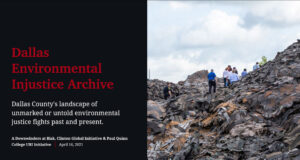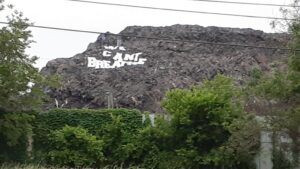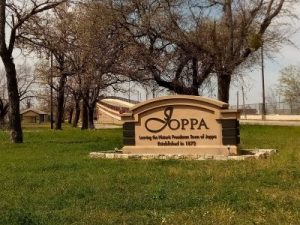Downwinders Chair is one of D’s 78 Women Making Dallas Great
D Magazine selected “78 Women Who Make Dallas Great” to profile in its September issue. Proud to say 26-year old Downwinders at Risk Chair Evelyn Mayo is one of them.

Meet the new Downwinders at Risk

Dallas Morning News Consumer Watchdog columnist Dave Lieber found himself listening in on the annual “State of the Air” presentation we’re always invited to give at the Arlington Conservation Council. Lots of information about smog and PM pollution but what really got his attention was the description in the Q&A about the wholesale transformation of Downwinders’ mission and board since 2017. He was so impressed he decided to write about it for his next column. Here’s the flattering result with some great pics our Chair Evelyn Mayo, our founder Sue Pope and (almost) our complete board as of August 2021. Thanks to Dave for the coverage and to all of you for supporting us through this transition.
For those without a DMN subscription we’re reprinting the entire article below:
Top anti-pollution group gets a makeover to an all-women board with young adults and people of color
Most nonprofit boards can only dream of bringing in younger members and people of color to reflect their communities. This one did it.
The phrase “trophy wall” caught my attention.
Jim Schermbeck, the wise old battler against Dallas-Fort Worth air pollution for the last quarter century, was bragging about his group’s new generation of leadership and its new focus on protecting neighborhoods.
I was in a webinar listening to Schermbeck, program director for pollution fighter Downwinders at Risk, as he gave an overview of our air quality (it’s bad!) when the trophy wall thing perked me up. It had something to do with Dallas City Hall officials leaving their jobs. Forgive the gruesome image, but the symbolism was that their heads were hung up on a wall.
I turned up the volume on my computer so I could hear.
He told a story about how the city of Dallas in recent years had allowed two northern Dallas neighborhoods to create their own land use plans. But when two southern Dallas neighborhoods tried to do the same, they were told by the city that neighborhood-based land use plans created by community members were no longer acceptable.
Putting it bluntly, white neighborhoods were allowed to create bottom-up plans that were presented to and accepted by city officials. But these neighborhoods where people of color live were forced to accept top-down plans imposed upon them by City Hall.
Schermbeck mentioned the group’s chair, Evelyn Mayo, a 26-year-old firebrand, and said, “This made her mad.”
Mayo helped organize several groups into the Coalition for Neighborhood Self-Determination, which agitated for fairness in community-created land use plans. Letters were sent to Dallas Mayor Eric Johnson, the City Council and City Manager T.C. Broadnax.
/cloudfront-us-east-1.images.arcpublishing.com/dmn/VHF2H4PGCBFPHDLIWRBDDDUSFU.jpg)
The power play appears to have worked. Three zoning officials decided to retire from the city. They are: Peer Chacko, the city’s director of planning and urban design; David Cossum, development services administrator; and assistant zoning director Neva Dean.
Kris Sweckard, the director of sustainable development and construction, was reassigned to the city’s aviation department on an interim basis.
“So at age 26, this woman has a department head on her trophy wall for a good cause,” Schermbeck was saying. “It’s just amazing to watch. If you ever think young people are not with it, and you want to build your confidence back up about people, please come to a board meeting or hang out with Evelyn and her friends for a while. They will restore your confidence about where we’re headed. She’s an amazing person, and our board is really great.”
/cloudfront-us-east-1.images.arcpublishing.com/dmn/A2SOKXOTI5HBBAGB6CVHNDCLJA.jpg)
Shine a spotlight
I asked Mayo how she felt about the trophy wall analogy. “I don’t think it’s something you should aspire to,” she said. “We were simply reacting to circumstances presented before us.”
Later, she toughened it up a bit, saying: “Whether it’s a trophy wall or not, what’s happening at City Hall is a product of their own incompetence.”
Downwinders board member Misti O’Quinn told me that the coalition shined a spotlight on one portion of neighborhood zoning, and when you shine a spotlight you can expose. What does that mean for city officials? “You take away their sense of security,” she said.
/cloudfront-us-east-1.images.arcpublishing.com/dmn/XOB66IBJRFCCPDQFPUCP7KZPLA.jpg)
I attempted to reach the four City Hall officials but was unsuccessful. When I ran this scenario up the flagpole to Broadnax, he provided a written statement to The Watchdog explaining that when several staffers announced their intention to retire this year, it presented an opportunity to realign their departments.
“Over the next several months,” he said, “we intend to simultaneously restructure permitting and planning and realign the departments and leadership that oversee them. Reorganizing these departments will maximize effectiveness and productivity.”
He made no mention of the coalition or its agitation.
Change with the times
This story runs far deeper than citizen agitation. Downwinders represents a model for how environmental and other nonprofits can alter their profile, their mission and their leadership.
As I looked at the group’s history, I saw how Downwinders has changed in recent years.
Formed in 1994 by Midlothian rancher Sue Pope and other rural residents and suburbanites, Downwinders’ mission for the longest time was fighting pollution caused by cement plants.
/cloudfront-us-east-1.images.arcpublishing.com/dmn/YOOOOF4INFGW5JU7KCBDVI6NUQ.JPG)
But by 2017, the year Mayo joined the board, it was becoming clear — thanks in part to the hideous Shingle Mountain dump site in southeast Oak Cliff — that Dallas needed a spotlight to focus on what activists and academics call historically racist zoning. That’s what allows dirty industries into poorer residential neighborhoods where people of color live. Correcting those inequities is called environmental justice.
In the next two years, the old guard board members, many of whom had served since the group’s creation, all dropped off. The board and its mission changed from rural/suburban to urban.
“It was very traumatic,” Schermbeck recalls. “But I’m so glad we did it because we’re more plugged in than ever before.”
Mayo says the worst moment came in 2019 when she was elected to the unpaid job of chair in what she calls “a somewhat contentious vote.”
The board is now all women; two are Asian-American, five are Black, two are Latina and three are white. Three members are in their 20s, and six are in their 30s. One member is 17 years old.
Most community nonprofits, especially in the traditional environmental arena, can only dream of putting together a board with that diversity.
Mayo, who teaches at Paul Quinn College, has a perfect resume for her leadership role. She majored in environmental science in college with a focus on race and ethnicity.
Working as a paralegal at Legal Aid of NorthWest Texas, she co-authored a study called “In Plain Sight,” which examined the governmental failures that allowed a disaster like Shingle Mountain to spiral out of control.
Then while teaching undergraduates at Paul Quinn, she and her students in 2020 completed a study – “Poisoned by Zip Code: An Assessment of Dallas’ Air Pollution Burden by Neighborhood.” You can guess the results of that survey.
The Downwinders’ main goal, in addition to continuing its legacy battle against dirty air, is to bring power and expertise to the city’s poorer neighborhoods that have had no say in dirty industries moving in.
/cloudfront-us-east-1.images.arcpublishing.com/dmn/3VRLM7INOFGSHGAAN667IY3NYI.jpg)
“The legacy of racist zoning perpetuates unless you fundamentally redraw the map through these land use plans,” she says. “People who are affected must be involved in the decision-making process about what their neighborhood will look like. This will probably have better outcomes for their health and wellness.”
Yet, she adds, “People who live there and bear the brunt of the pollution are still not at the decision-making table.”
Mayo says her group needs all the help it can get.
“No matter who you are, we can put you to work if you’re interested and willing,” she says.
Note: A tip of The Watchdog’s hat to Downwinders’ board members: Cressanda Allen; Satavia Hopkins; Misti O’Quinn; Essence Tetteh; Marsha Jackson; Cindy Hua; Amber Wang; Idania Carranza; Soraya Coli; Amanda Poland; Michelle McAdam; and Shannon Vorpahl.
One of Dallas’ Biggest Polluters Appears to Be Breaking the Law in West Dallas
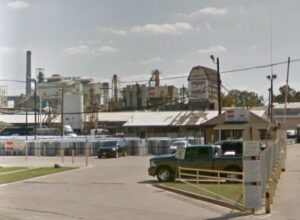 FOR IMMEDIATE RELEASE : 8 am Wednesday July 21
FOR IMMEDIATE RELEASE : 8 am Wednesday July 21
Contact: Raul Reyes Jr.: President, West Dallas 1 – 469-880-3811
Evelyn Mayo, Neighborhood Self-Defense Project – 774-810-0849
“GAF is the new RSR.”
Alliance Says West Dallas Polluter is Operating Illegally and Poisoning Residents…Just Like Infamous Lead Smelter. And They Want it Gone.
Giant shingle factory doesn’t have needed permits from City; Monitors show its likely violating federal air pollution standards too
(Dallas)– In a stunning replay of West Dallas environmental justice history, a new alliance of
groups says the largest polluter in West Dallas lacks required City of Dallas documents to operate, and could be in potential violation of federal air pollution standards. It’s the same circumstances that forced the former RSR lead smelter, once also located on Singleton Boulevard, to close in the 1980’s.
“GAF is the new RSR” said Raul Reyes, President of neighborhood group West Dallas 1, and spokesperson for the new coalition of allies, “This factory is operating illegally, lacks basic pollution controls, and is too dirty to be doing business in West Dallas neighborhoods. And just like RSR, it should be closed.”
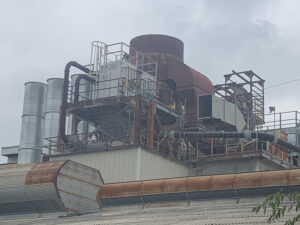 GAF has operated its West Dallas asphalt shingle factory for so long a lot of its pollution is “grandfathered” – unfiltered by any modern controls like “scrubbers” despite that technology being capable of removing up to 99% of sulphur dioxide emissions. In the last EPA inventory available from 2019, it was listed as Dallas County’s third largest air polluter with over 260 tons being spewed from GAF into surrounding neighborhoods that year alone. That includes 125 tons of Sulfur Dioxide pollution – more than any other facility in Dallas.
GAF has operated its West Dallas asphalt shingle factory for so long a lot of its pollution is “grandfathered” – unfiltered by any modern controls like “scrubbers” despite that technology being capable of removing up to 99% of sulphur dioxide emissions. In the last EPA inventory available from 2019, it was listed as Dallas County’s third largest air polluter with over 260 tons being spewed from GAF into surrounding neighborhoods that year alone. That includes 125 tons of Sulfur Dioxide pollution – more than any other facility in Dallas.
For years, surrounding residents and workers have reported sulfur-like rotten egg odors in the Singleton corridor around GAF, leaving them with headaches and nausea. But it’s the tiny pieces of soot being emitted from the facility that could get the company in trouble with the EPA. Using off-the-shelf Purple Air monitors for Particulate Matter, West Dallas residents independently monitored PM pollution around the GAF plant over the past two years. Results show levels of air pollution that likely violate both the 24-hour and annual national standards for PM 2.5 microns or smaller. If official EPA monitoring confirms the violations, the part of West Dallas around GAF, which hosts many other industrial polluters that are likely contributing to this pollution, could be declared a “non-attainment area” for PM pollution. GAF and other West Dallas PM polluters would have to submit a plan to decrease their emissions and new industries would be subject to stricter limits. RSR was also violating air pollution standards when the City of Dallas began to seek its closure in the late 1970’s.
Just like lead scientists believe there’s no “safe level” of exposure to PM pollution. A violation of its national ambient air standard is a dangerous condition that can leave lasting health harm among the hundreds of residents who live next to GAF, especially children.
Reviewing the results from the GAF monitoring, Dr. Natalie Johnson, a faculty member of Texas A&M’s School of 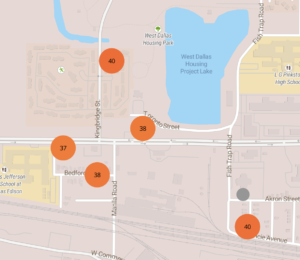 Public Health specializing in respiratory toxicology and environmental health warned, “If verified by EPA, these numbers are concerning. Exposure to levels over the EPA regulatory limits can lead to chronic diseases, such as heart disease, stroke, and premature death. The immune system, reproductive system, and developmental functions can also be harmed. The elderly, children, and infants are particularly vulnerable.”
Public Health specializing in respiratory toxicology and environmental health warned, “If verified by EPA, these numbers are concerning. Exposure to levels over the EPA regulatory limits can lead to chronic diseases, such as heart disease, stroke, and premature death. The immune system, reproductive system, and developmental functions can also be harmed. The elderly, children, and infants are particularly vulnerable.”
Janie Cisneros, who lives with her family just feet from GAF’s fence line and hosted one of the monitors said “I grew up on Bedford Street and GAF was always a big presence. Now that I moved back to raise my own family, I see how disgusting and unhealthy the air is. It often keeps me from playing with my daughter outside.”
This is the first time in Texas that new low-cost hyperlocal air monitoring by residents has revealed potential violations of a national air pollution standard. Despite years of complaints, there are no City of Dallas, State, or EPA monitors near GAF.
At the same moment GAF is being accused of creating hazardous levels of air pollution, a research of City Hall documents by staffers for the Southern Dallas Neighborhood Self Defense Project revealed that GAF doesn’t have a current Certificate of Occupancy or the Special Use Permit (SUP) from the City of Dallas it needs to be operating at the site.
The RSR smelter also never operated with the SUP it was required to obtain. More recently, the six-story dumping ground for the asphalt shingles that GAF and others produce, that became Shingle Mountain in Southern Dallas, was illegal from the first day it operated because it also lacked a required SUP and Certificate of Occupancy.
Armed with this new information, West Dallas residents notified the City of Dallas about GAF’s illegal status. WD1 representatives have been told the research is correct and the City is now investigating. Without the Special Use Permit, GAF’s shingle-making is a “non-conforming” use and the City could initiate the same proceedings it used to eventually close RSR.
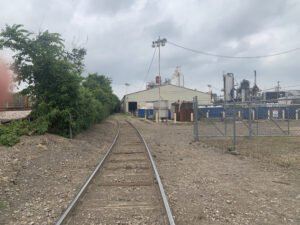 This dramatic news about GAF’s legal status and pollution levels comes precisely at the moment the company is applying for a renewal of its “Title V” operating permit from the State and EPA. Usually a mundane regulatory rubber-stamping, this process now has the potential to substantially add to the company’s headaches.
This dramatic news about GAF’s legal status and pollution levels comes precisely at the moment the company is applying for a renewal of its “Title V” operating permit from the State and EPA. Usually a mundane regulatory rubber-stamping, this process now has the potential to substantially add to the company’s headaches.
After months of requests by West Dallas 1 and elected officials, the Texas Commission on Environmental Quality (TCEQ) will be holding a virtual public hearing on the permit on July 29th at 7 pm.
Residents and others who want to ask questions or provide comments during the hearing may access the webcast by following this link:
https://www.gotomeeting.com/webinar/join-webinar
and entering 192-616-739 along with your email address or may call (512) 239-1201 at least one
day prior to the hearing for assistance in accessing the hearing and participating telephonically.
Members of the public who wish to only listen to the hearing may call, toll free, (415) 655-0060 and enter access code 569-744-316.TCEQ staff is recommending that you join and register at least 15 minutes before the hearing begins. A copy of the permit application can be viewed at the Dallas West Branch Library (2332 Singleton Boulevard). General complaints can be submitted in writing up to the hearing date to the TCEQ here:
https://www.tceq.texas.gov/assets/public/compliance/monops/complaints/complaints.html and objections to the permit renewal can be submitted here: http://www14.tceq.texas.gov/epic/eComment/.
Besides WD1, the groups lining-up to oppose the federal permit renewal are a combination of Dallas environmentalists, neighborhood associations, and social justice organizations, including Dallas Sierra Club, Downwinders at Risk, Public Citizen, and Southern Sector Rising.
After a review by TCEQ GAF’s permit renewal then heads to the Biden Administration’s EPA, which has pledged to work with communities of Color to reverse the kind of environmental racism the groups claim GAF is guilty of practicing.
“No permits. The wrong zoning. Dangerous levels of air pollution. Right in the middle of Black and Brown neighborhoods. Tell me how this ISN’T a repeat of the environmental racism West Dallas has been fighting for decades,” said Reyes. “We expect the Biden Administration to make good on its promise to end this kind of unacceptable discrimination.”
City Hall’s New Exploding Cigar is Why These Former Plan Commissioners Must Win On Saturday

Dallas City Hall Staff has once again lit an exploding cigar. You know the ones you see in cartoons? An unsuspecting fellow strikes a match to what looks like a normal cigar…and then BAM! Powder burns and singed hair.
This new cigar is being smoked by Staff as if nothing was wrong, but the fuse is already lit. It’s just a matter of time.
Unlike previous Staff-manufactured exploding cigars this one isn’t a project, it’s a process. That makes it an even more insidious threat to Dallas neighborhoods than past exploding cigars sold under the brand names of “Trinity Tollroad,” “Treeless Golf Courses,” and “Gas Drilling in Parks.”
Those were one-offs that affected specific neighborhoods or sections of Dallas. This loaded stogy challenges EVERY neighborhood in EVERY part of town.
This cigar still lacks a catchy battle cry moniker – “Neighborhood Planning Process” is a mouthful and not very descriptive. But the issue is basically self-determination and local control. City Planning Department Staff, led by Director Peer Chacko, are saying Dallas residents can’t be trusted to plot the future of where they live. Chacko and Company have therefore selflessly suggested Staff should take on this task, even if they’ve never set foot in most of the neighborhoods whose fates they’re deciding.
To give themselves veto power over residents, Staff threw away a process where residents had the final say and substituted a new one that doesn’t give residents’ plans any path for Council adoption. Only the Staff-led ones have a chance. “We had to destroy the planning process in order to save it” echos an approach you might remember from more exotic and tragic national exploding cigars of the past 50 years.
Another Bad Sign: Staff invented the need for this new anti-resident planning 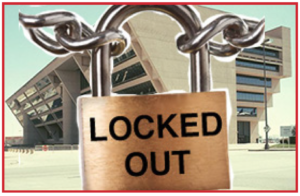 process out of thin air. It wasn’t mandated by a vote from the the City Council. There was no public pressure. No “blue ribbon” panel suggested it. There was no reason to change anything…until there was. Just light that Big Boy up!
process out of thin air. It wasn’t mandated by a vote from the the City Council. There was no public pressure. No “blue ribbon” panel suggested it. There was no reason to change anything…until there was. Just light that Big Boy up!
Is the timing suspiciously racist? Yes it is. After letting a couple of predominantly white North Dallas neighborhoods construct and pass their own plans under the previous system with nary a hint of dissatisfaction, Staff pulled the plug only when Southern Dallas neighborhoods began using it to roll back racist industrial zoning. They might as well have just said, “We certainly didn’t mean for THIS to happen.”
Moreover, Staff believes they don’t need the Council’s permission to trash the neighborhood planning process and replace it with something else they just made up on their own. They’re not asking. They’re telling.
In other words, this is one really big, in-your face, Freudian-inducing, gun powder-packed presumptuous cigar.
Which is why Dallas neighborhood advocates across the city should be rooting for Jaynie Schultz and Paul Ridley to win their run-offs in D11 and D14. When it comes to these kinds of threats, they’re the Bomb Squad of Dallas City Hall exploding cigars.
Both are former Plan Commissioners who have lots of experience running across the room with scissors in the nick of time to cut the burning ends off these things before they can detonate.
As a Commissioner from her own D11 and then stepping in as an interim replacement for D8 a well, Schultz is a major reason there are not now at least four more batch plants in Joppa and nearby Flora Farms. She understands why Flora Farms residents want to rescue their neighborhood from decades of racist zoning. She’s taken on Staff directly and wrangled eight or more votes to deny permits to Southern Dallas polluters that they had no problem allowing. She knows the language of urban planning as well as the process. Her BS antennae are very long and she knows how to win.
well, Schultz is a major reason there are not now at least four more batch plants in Joppa and nearby Flora Farms. She understands why Flora Farms residents want to rescue their neighborhood from decades of racist zoning. She’s taken on Staff directly and wrangled eight or more votes to deny permits to Southern Dallas polluters that they had no problem allowing. She knows the language of urban planning as well as the process. Her BS antennae are very long and she knows how to win.
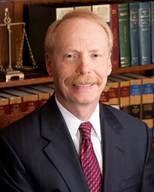 If you like seeing Dallas parks and the Trinity River without any drilling rigs on or near them, you can thank Paul Ridley. That such rigs would be showing up was already a “done deal” according to then-Mayor Mike Rawlings. As a Plan Commissioner during the Dallas Gas Wars Ridley played a critical role in forcing the truth out of Staff and industry so that what looked like a Plan Commission endorsement became a total rebuke that Council then followed. He also speaks Planning, has long BS antennae, and knows how to assemble a winning coalition.
If you like seeing Dallas parks and the Trinity River without any drilling rigs on or near them, you can thank Paul Ridley. That such rigs would be showing up was already a “done deal” according to then-Mayor Mike Rawlings. As a Plan Commissioner during the Dallas Gas Wars Ridley played a critical role in forcing the truth out of Staff and industry so that what looked like a Plan Commission endorsement became a total rebuke that Council then followed. He also speaks Planning, has long BS antennae, and knows how to assemble a winning coalition.
Dallas residents need them both in office in order to lead a freshly-inaugurated City Council to a vote to undo this done deal, before it undoes them.
Already incumbent CM Chad West is reaping the initial whirlwinds of dissent. “The West Oak Cliff Area Planning Initiative” was to be the first uncontroversial example of Staffs’ new system. It’s not going well.
Residents are complaining of a top-down, Staff-led process that excludes many neighborhoods 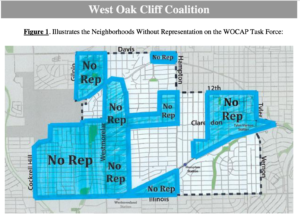 in the large “area” boundary Staff has drawn. They say they aren’t being represented, and the City’s outreach effort is poor to non-existent when it comes to information in Spanish. They also object to the prohibition on adopting their own neighborhood-led plan. A new neighborhood association just formed. The West Oak Cliff Coalition’s first goal is to stop the Planning Department from using its new neighborhood planning process on their neighborhoods. The Coalition’s leadership sent a letter asking West to back their demands. As of this writing, no word from West.
in the large “area” boundary Staff has drawn. They say they aren’t being represented, and the City’s outreach effort is poor to non-existent when it comes to information in Spanish. They also object to the prohibition on adopting their own neighborhood-led plan. A new neighborhood association just formed. The West Oak Cliff Coalition’s first goal is to stop the Planning Department from using its new neighborhood planning process on their neighborhoods. The Coalition’s leadership sent a letter asking West to back their demands. As of this writing, no word from West.
If this is the reaction from previously unorganized neighborhoods in Oak Cliff, imagine the outcry when the full scope of the Staff’s changes become common knowledge among hardcore neighborhood advocates in East Dallas, White Rock Lake, or Lake Highlands. The opportunity for effective city wide organizing is not going unnoticed. It’s all headed for a showdown at the Horseshoe. We just need to make sure Schultz and Ridley are sitting there, scissors in hand, as part of the welcoming committee.
So no matter where you live in Dallas, please help Jaynie Schultz and Paul Ridley out this Saturday – with money, with labor, with a call to friends who live in their districts. The neighborhood you save may be your own. The Bat Signal is on. We’re at DEFCON 1. Dallas needs its Bomb Squad back on duty again.
Earth Day 2021: Our New Archive of Local Frontline Environmental Justice Fights
It’s Earth Day 2021. Board members Cindy Hua and Evelyn Mayo built this great archival tool to explore the history of EJ frontline fights in Dallas County. Click the image to start looking around.
Expect updates that expand its reach in the coming months. To contribute to our Frontline Fund to support Community Organizing to fight current frontline fights, click here.
Current Dallas City Council Members Failed History in 2020. They Don’t Deserve Your Support in 2021
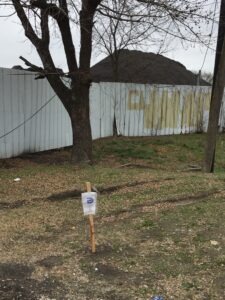
The response didn’t match the crisis. City of Dallas citation notice outside Shingle Mountain in 2019.
For almost two continuous decades Dallas residents had a string of thoughtful, sincere, and righteously-angry advocates who served on their City Council.
As Mayor, Laura Miller just about single-handedly stopped over a dozen new coal plants from being built by Rick Perry and implemented the region’s first Green Procurement ordinance. As a council member, Angela Hunt hunted down waste, corruption, and Staff shenanigans. If she couldn’t get her peers to pay attention, she made sure a reporter did. Scott Griggs and Philip Kingston, then Mark Clayton followed suit. They defeated the zombie Trinity Toll Road AND gas drilling – the latter being “a done deal” according to then-Mayor Rawlings.
Sometimes they fought their council opponents directly. Sometimes they made sure documents that were never supposed to see the light of day got their own spotlight. You knew these partisans would find a way to advance the cause. Because that cause was why they wanted to serve.
But when Griggs couldn’t overcome the cynical Mayoral bid of Eric Johnson, and Kingston’s bad boy behavior cost him his Council seat, the horseshoe lost its last devoted grassroots insurgency. As a result, the current Dallas City Council is the least progressive in deed, if not in rhetoric, since 2002.
Who among the present 15 members could a City Hall observer nominate as the rightful heir of any of those past True Believers? Not a one.
Residents have no confidence that current council members would put ANY cause, no matter how righteous, before their own political ambitions. That’s not a prediction. 2020 provided the proof.
There were exactly two urgent historic crises that brought nationwide attention to Dallas city government last year: Police response to the George Floyd protests, and Shingle Mountain. This Council failed to meet both with integrity.
POLICE ABUSE AND REFORM
Even after the loss of eyes and other serious physical harm inflicted by a Dallas Police Department that was out of control during the May and June protests, not a single Council Member called for the Police Chief to resign. Not a one.
It took the former Chief being caught in a lie regarding that excessive force months after the fact that led to her departure. There were no brave stances from Council Members. Not a one.

Even after Dallas’ youth and People of Color organized well-attended and persistent protests before and during the budget process to win re-prioritization of police funding, not a single City Council member proposed a budget that reflected their demands. Not a one.
We’ll leave it to the long-time advocates of that cause who are now council candidates, including Changa Higgins, running to replace Adam Bazaldua in District 7, to explain how badly the Council failed to meet the moment. But there’s no question that when a large segment of Dallas residents wanted something done about the use of force and the redeployment of resources away from the Police Department, they had absolutely no champion on the current City Council. Not a one.
What are the consequences to those elected officials for their inaction? For most Dallas “progressive” groups making endorsements on the Council Races, there aren’t any. Not a one.
SHINGLE MOUNTAIN
The entire Council also turned their backs on Marsha Jackson and her neighbors while Choate Street residents suffered daily health problems caused by the City’s most high-profile example of Southern Dallas negligence, Shingle Mountain.
During the 2019 election, 10 current city council members – Chad West, Adam Medrano, Carolyn Kind Arnold, Jaime Resendez, Omar Narvaez, Adam Bazaldua, Tennell Atkins, Paula Blackmon, Cara Mendelsohn, David Blewett – said they’d work to re-establish the Environmental Health Commission if they got elected. Not a single City Council member made a motion to do so when Jackson and her allies asked them to follow through on their commitments last April. Not a one.
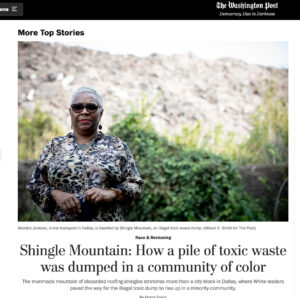
Not a single council member has ever apologized to Jackson. There were no leaking of documents that would have shown just how much the city’s silly demand for some kind of cash payment from the landowners needlessly delayed the clean-up at the dump for over a year. No push back to staff’s irrational claims about why they couldn’t have used the illegal status of the dump to enter the property at any time after it opened and begin a clean-up. Jackson could not count on a single current city council member to be her advocate. Not a one.
While nobody was expecting North Dallas members to take up these causes, there were supposed to be “Progressive” city council members that would carry on the work of Hunt/Griggs/Kingston. Turns out, not so much.
The best that can be said about Chad West is that he’s no Scott Griggs. Adam Medrano seemed to be coasting on his way to terming out. Casey Thomas was never part of that crowd and neither was Carolyn Arnold. Nobody expected much from Jamie Resendez in his first term and he delivered. Paula Blackmon? She was the Mayor Rawlings PR aide when he was calling gas drilling in Dallas a done deal and those Real Progressives were fighting both of them.
But by far the steepest falls from expectations to performance were Omar Narvaez and Adam Bazaldua.
DISTRICT 6

CM Navarez knows the names of every character in the Star Wars universe, but couldn’t name any children suffering under Shingle Mountain.
Almost two years into the job and Council Member Narvaez still tells everyone that will listen that he never expected to be the Chair of the Council’s Environmental Committee and didn’t know that much about environmental issues. His real passion was for housing, but for some reason, the Mayor gave him responsibility for the Environmental Committee, and the shepherding of the City’s precious Climate Plan.
Maybe because of his lack of familiarity with the subject matter, or maybe because it was made clear by the Mayor and Staff that his job would be exclusively about getting the city’s climate plan passed but he froze like a deer in headlights when Marsha Jackson needed him most.
He refused to consider adding the re-establishment of the Dallas Environmental Health Commission to the Climate Plan ordinance despite Ms. Jackson’s personal pleas that she and other residents needed a forum that took these problems seriously.
He kept using the old “it’s in litigation” dodge in public to avoid answering any questions about Shingle Mountain even though city officials routinely discussed it when it suited their PR agenda.
He never met with Ms. Jackson, inquired about her health, toured the mostly Latino neighborhood or asked what he could do as the Chair of the City’s Environmental and Sustainability Committee to relieve their suffering. He never offered to lobby for more air monitoring or health protections. He never offered to do anything.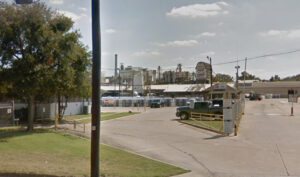
Despite his district hosting the region’s largest asphalt shingle factory (and Sulfur Dioxide polluter), GAF, whose products filled the 6-story Shingle Mountain dump, the Chair of the City’s Environmental and Sustainability Committee never discussed this environmental justice connection between POC neighborhoods in Dallas.
Despite two well-researched published reports identifying vast inequities in the way the City enforces Code in Southern Dallas and how its air pollution burdens are distributed, the Chair of the City’s Environmental and Sustainability Committee held no hearings or meetings related to these environmental justice issues during the last 18 months. Not a one.
Despite national media coverage of the City’s inept handling of Shingle Mountain, and the city’s poor environmental justice record, including articles in the Washington Post and Philadelphia Tribune, and a hour-long documentary on BET, the Chair of the City’s Environmental and Sustainability Committee held no hearings or meetings related to how to avoid another Shingle Mountain during the last 18 months. Not a one.
Despite never holding any meetings devoted to environmental justice the Chair of the City’s Environmental and Sustainability Committee did find an urgent need to convene a special task force to examine and come back with solutions to the pressing issue of Oncor’s cutting down 5 acres of trees near White Rock Lake. Replacing trees in North Dallas, not reducing human suffering in Southern Dallas, was the priority of a council member representing an overwhelmingly POC district, which also happens to the the birthplace of the modern Environmental Justice movement in Dallas.
And of course, the majority of his Committee Chairmanship was spent making sure Staff got its way with the passage of the city’s “North Dallas” Climate Plan, of which many dollars in potential grants depends, if not actual changes on the ground. The plan does zero to address problems like Shingle Mountain and GAF, does nothing for Narvaez’ district, but is very, very concerned about stormwater management and tree cover.
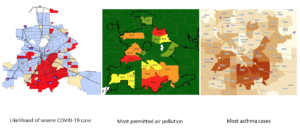
Throughout the entirety of the Shingle Mountain crisis, CM Narvaez was a good soldier for the Mayor and Staff. Which made him an awful Chair of the Environmental Committee for Southern Dallas residents during the most serious environmental justice controversy in the last 25 years.
Not content to just do no good in that case, Narvaez has gone out of his way to praise and campaign with District 8 Council Member Tennell Atkins, a primary architect of Shingle Mountain. In doing so, he fuels Atkins’ mind-blowing Big Lie that he was the facilitator of a clean-up instead of a major obstacle. Atkins is among the most unconscionable right-wing members on the Council but Narvaez treats him like a conquering hero, rubbing salt into Marsha Jackson’s wounds with every unsolicited and unearned act of praise.
Was it embarrassment over this performance this last year that kept Narvaez from granting an interview with Soledad O’Brien for her BET documentary? Instead, the Chair of the City’s Environmental and Sustainability Committee let Atkins alone represent the City on the record.
And he’s followed Staff’s lead right over the cliff on other important environmental health issues too. This might be hard for his Progressive admirers to believe, but he actually bragged about Joppa getting an unprecedented TCEQ air monitor when in fact it’s located three miles north in Bonton.
Then he made that lie worse by claiming that this TCEQ monitor’s location – miles away from industrial sources of pollution in Joppa – could more accurately show what the air was like there than if it had been put in Joppa itself.
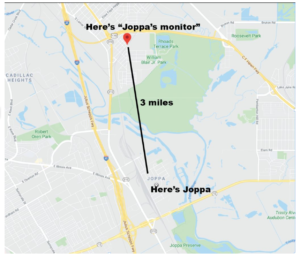 You read that right. According to the Chair of the City’s Environmental and Sustainability Committee, air monitors three miles away from Joppa more accurately reflect the air Joppa residents are breathing than monitors right outside their front doors.
You read that right. According to the Chair of the City’s Environmental and Sustainability Committee, air monitors three miles away from Joppa more accurately reflect the air Joppa residents are breathing than monitors right outside their front doors.
Does CM Narvaez really believe this, or is he just parroting Staff’s opposition to local air monitoring? Which interpretation is more damning?
And what’s his inevitable pretzel logical response to finding out that his own District’s residents are embracing local neighborhood monitoring? Will he be advocating those “local” West Dallas monitors to be located three miles north, in Irving, to get a “truer picture” of West Dallas pollution burdens?
The cynicism is strong in this one.
CM Narvaez should have been the Chair of Housing, not the Environmental Committee. As the latter, he’s set the cause of environmental justice back years. Despite being an over-the-top Star Wars geek, when the time came to make his own choice in his own movie, he went over to the Dark Side.
DISTRICT 7

Despite appearances, CM Bazaldua is neither Jewish or an environmentalist.
CM Adam Bazaldua has disappointed in a slightly lower profile, albeit more personal way.
Bazaldua represents District 7, home to the Freedman’s town of Joppa, and per capita, Dallas’ most polluted neighborhood.
In Joppa sits TAMKO, the other large asphalt shingle factory that operates in a Dallas POC neighborhood. Shingle Mountain is literally right down Central Highway from Joppa, and TAMKO. You can routinely smell its asphalt cooking at all times of day. Along with GAF, it was TAMKO’s products you saw most often being dumped at Shingle Mountain.
But Bazaldua, like Navarez, never brought up that toxic connection that binds his constituents to Choate Street residents. Not once.
In fact, you’d be hard pressed to find anything related to environmental justice concerns uttered by Bazaldua once he took office despite Joppa being a battle ground for such concerns for at least the past three years. He’s conspicuously avoided any mention on it in his campaign material. You’d never know his district was bothered by any pollution problems at all.
When Staff, and CM Navarez told the public there was a new monitor in Joppa that was really in Bonton, he didn’t disagree. He went along with the charade. He didn’t demand overdue air monitoring for a community whose residents had been asking for it since at least 2018.
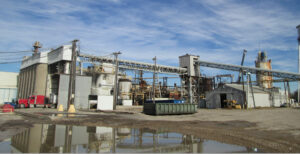 There was no effort by the Council Member to join residents in opposing the Joppa-based Austin Asphalt batch plant permit renewal, even after it was learned that the plant’s air modeling hadn’t been revised from its original sparse West Texas location to reflect its new dense urban Dallas spot.
There was no effort by the Council Member to join residents in opposing the Joppa-based Austin Asphalt batch plant permit renewal, even after it was learned that the plant’s air modeling hadn’t been revised from its original sparse West Texas location to reflect its new dense urban Dallas spot.
There was no call for locomotive electrification in the Joppa switch yard, and in fact two more tracks were laid down that can only result in more carcinogenic black soot from more diesel engines in more locomotives.
Most disheartening however, was the fundamental error in elected official protocol Bazaldua committed last year when Marsha Jackson turned to him in desperation to intervene and advocate for the Dallas Environmental Health Commission on the eve of the Climate Plan vote.
Jackson asked him to look at the language in the proposal she and her Southern Sector Rising allies had 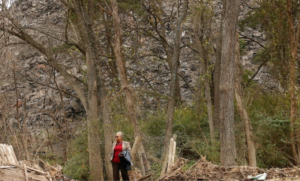 submitted to him. She asked him to take it to Chairman Navarez and make the case for what both had pledged to do less than a year earlier. And then she asked hm to please let her know the results of that discussion before the Council voted on the Climate Plan. He told her he would do so.
submitted to him. She asked him to take it to Chairman Navarez and make the case for what both had pledged to do less than a year earlier. And then she asked hm to please let her know the results of that discussion before the Council voted on the Climate Plan. He told her he would do so.
He didn’t.
When a 61-year old woman being buried daily under tons of waste that the City helped put there comes to you and asks you to plead her case to another Council Member in private and you not only never even read her proposed language, you never bother to even call her back – it is not acceptable behavior from any kind of Council Member, much less one that is described as “progressive.” And no, he never apologized.
What are the consequences to the Council for their collective snub to Marsha Jackson? For most Dallas “progressive” groups making endorsements on the Council Races, there aren’t any. Not a one.
NOT DESERVING
Maybe you think this criticism is all too-narrow. Too specific. It doesn’t account for all the “good things” accomplished by these “progressive” city council members that balance out these woeful absences of empathy and courage. It’s too much to punish them all for losing their way on just these two issues.
But those “good things” were not hard sells, they didn’t require risk-taking. Here’s an exercise: name one issue the Progressives on this risk-averse Council have put themselves, their positions as elected officials on the line for. We’ll wait.
Maybe you weren’t seriously injured by Dallas police in a protest. Your house probably doesn’t back up to 140,000 tons of illegal hazardous waste.
 But maybe next week, next month, or next year you will be in a similar situation. Through no fault of your own you’ll need a Council Member to intervene on your behalf. But if it conflicts with the Staff’s agenda, or makes the Council Member go out on limb, you might be disappointed.
But maybe next week, next month, or next year you will be in a similar situation. Through no fault of your own you’ll need a Council Member to intervene on your behalf. But if it conflicts with the Staff’s agenda, or makes the Council Member go out on limb, you might be disappointed.
If the Council won’t take on the Police when they put out eyes, or polluters when they dump illegally by the truckload, what are the odds your cause will rate action?
That’s the point. Just like all of us, a Council Member shows their true selves in times of crisis, not when the going is easy. In 2020 there were two times history called, and not a single Dallas Council Member answered the phone. Not a one.
What other way can Dallas “Progressives” proclaim these things matter other than using the blunt language of the ballot box and refuse to vote for them? There aren’t any. Not a one.
Support a Dallas Climate Committee AND Restoring the Environmental Health Commission
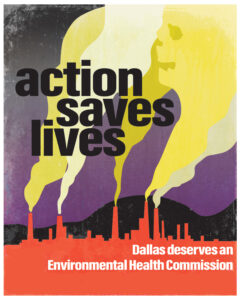
In the next seven days you can help us change the way Dallas City Hall looks at “environmental issues.”
One of the most important lessons of the Shingle Mountain crisis is the high price residents paid by having no environmental health expertise at Dallas City Hall.
This coming Friday, February 12th, the Interim Climate Committee Chaired by former City Council Representative Sandy Greyson is voting on how to organize a new approach to environmental issues in Dallas.
Southern Sector Rising and Downwinders at Risk are formally asking this interim committee to recommend a solution advocated for the last two years by Dallas Environmental Justice advocates: two separate committees. One to track the Dallas Climate Plan, and restoration of the Environmental Health Commission to tackle on-going environmental controversies and policies.
Making sure the numerous climate plan timelines and goals are met will be a full-time job.
EJ advocates say it would be unfair and unwise to also assign this committee the additional responsibility to hear, investigate, and offer policy recommendations on environmental health issues like Shingle Mountain, batch plant permitting, and COVID inequities. They’re urging Former Council Woman Greyson and the Interim Committee to adopt the two committee solution.
You can add your voice to this two committee option by clicking on this link and sending a “ClickNSend” email directly to Chairperson Greyson and Interim Committee members. We’ve got the template written and you can add your own message as well.
If you’re a Dallas resident, please help us bring a much needed focus on environmental health issues to City Hall. Thanks.
We Did This: A Shingle Mountain Clean-Up is Coming
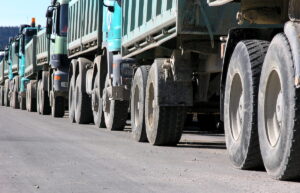
Despite the flurry of cynical and self-serving photo ops and press releases that Dallas City Hall churned out on Monday celebrating the beginning of a clean-up at Shingle Mountain, no waste was removed from the site yesterday. Nor will any be removed today.
But thanks to you, a clean up is coming. And also thanks to all you, that clean-up is suddenly more concerned with the health of Choate Street residents.
Last week, after a required 30-day public notice period, a state court approved a settlement between the illegal dump’s landowner, the State of Texas and the C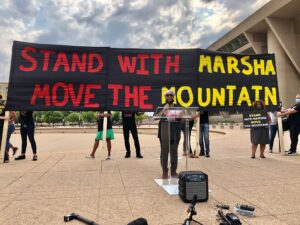 ity of Dallas that sets the table for removal of all “above ground” material. On Monday, contractors for the city were installing air monitors around the dump to record the levels of dust created when bulldozers begin loading the estimated 100,000 tons of hazardous waste into waiting 18-wheelers for the half mile trip to the McCommas landfill.
ity of Dallas that sets the table for removal of all “above ground” material. On Monday, contractors for the city were installing air monitors around the dump to record the levels of dust created when bulldozers begin loading the estimated 100,000 tons of hazardous waste into waiting 18-wheelers for the half mile trip to the McCommas landfill.
According to a separate agreement between the City and the landowner, the City has until December 25th to “begin” the removal process, i.e. sending trucks to actually haul off waste.
This result was anything but a foregone conclusion when the “Move the Mountain” campaign began last August 5th with a new conference at City Hall demanding the illegal dump be gone by the end of the year.
Only 4 months ago City Hall hadn’t made any commitments to a clean-up and had no estimate for when one would take place. The City Council had just unanimously rejected pleas from Choate Street residents to re-establish the Environmental Health Commission as part of a new Climate Plan. We were at a low ebb in our campaign.
But a strategic and constant barrage of public protest and shaming – mock trials, leafleting the Mayor’s law firm, 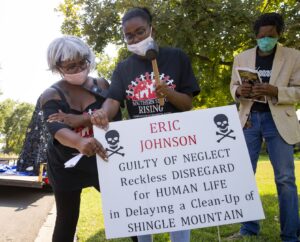 dumping waste at City Hall – along with the attendant embarrassing media coverage, made the City of Dallas actually commit itself to a clean-up it hadn’t planned on doing quite as fast, if at all.
dumping waste at City Hall – along with the attendant embarrassing media coverage, made the City of Dallas actually commit itself to a clean-up it hadn’t planned on doing quite as fast, if at all.
Keeping constant pressure applied for four months was often exhausting, but momentum grew with each new demonstration. November 16th might have seen “peak” Shingle Mountain coverage with publication of a long and well-written expose in the Washington Post, a public demonstration at the dump’s gate counting down the days until a clean-up was supposed to begin and a crew from Solodad OBrien’s upcoming BET documentary in town to film it for a premiere in February.
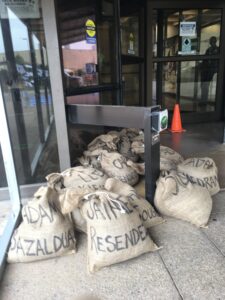 Thanks to everyone who showed up to those demonstrations of support. Whether you attended one or all of them, your presence made a difference.
Thanks to everyone who showed up to those demonstrations of support. Whether you attended one or all of them, your presence made a difference.
Those of you who sent in public comments this last month also had an impact. Initially, neither the State nor City expressed the least bit of concern about the health of Choate Street residents during the messy business of removing the waste. No specific provisions for controlling dust or monitoring air quality were included in the City agreement or State settlement.
But after over 50 letters and emails worth of comments were sent and included in the public record, the City suddenly got religion. It included dust control measures and air monitoring in its final description of the clean-up to the court. Lawyers for Marsha Jackson, Co-Chair of Southern Sector Rising, and a Downwinder board member cited your public comments as the reason the City included these new safeguards at the last minute. So congratulations a second time.
Now what?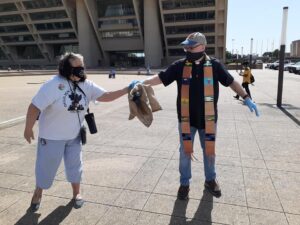
The settlement and agreements signed by the State and City are vague about what happens after the land surface is cleared of waste. Will there be any monitoring wells drilled to see if contamination seeped into the groundwater? Will the clean-up extend below the ground as well as above if the soil is contaminated? If pollution is found in the soil or water, what level of contamination is “acceptable”, i.e. what are the clean-up levels then?
And what and who will be responsible for the health costs -financial and physiological – accumulated by Ms. Jackson and the other Choate Street families?
Residents have drafted their own neighborhood plan for redevelopment that drastically changes the zoning in their community. They’ve submitted it to City Hall. But the same City Council Member that was taking unearned credit for Shingle Mountain’s removal on Monday is fighting this neighborhood plan tooth and nail.
District 8 City Council Member 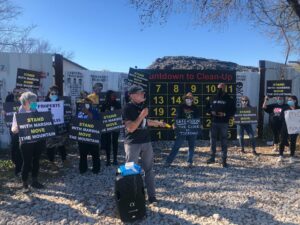 Tennell Atkins is one of the biggest reasons Shingle Mountain exists at all, and why its removal has been so delayed. He’s been nothing but an obstacle to be overcome instead of an ally for his constituents. Adding insult to injury, he’s now standing in the way of Choate Street and Flora Farms residents being able to rebuild their community from the devastation he’s inflicted on them.
Tennell Atkins is one of the biggest reasons Shingle Mountain exists at all, and why its removal has been so delayed. He’s been nothing but an obstacle to be overcome instead of an ally for his constituents. Adding insult to injury, he’s now standing in the way of Choate Street and Flora Farms residents being able to rebuild their community from the devastation he’s inflicted on them.
Atkins is up for re-election in May and it’s our hope that all of you who made this Shingle Mountain clean-up happen will stick around and finish the job by helping us remove this political tumor that threatens the future of Southern Dallas.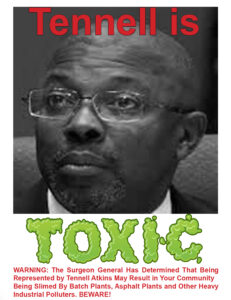
Sunday December 13th was the two-year anniversary of the very first Robert Wilonsky column about Shingle Mountain in the Dallas Morning News. Some of us believed that first column would expose the problem and move officials to act to resolve it. 13 Wilonsky Shingle Mountain columns later, we’re still waiting on the trucks that should have arrived in January 2019.
If they show up before Christmas Day , it will be one of the best, most satisfying moments of a terrible year. But it won’t be the end of the struggle over racist zoning that began on Choate Street. That struggle is just beginning.
Send Your Public Comments for a SAFE Shingle Mountain Clean-Up
What:
Public Comments on the State’s Settlement with Shingle Mountain landowner
When:
Now thru Sunday, Dec 6th
How:
Use our ClickNSend email feature to send your comments to Texas Attorney General’s office in 90 seconds
Why:
To make sure residents’ health is protected during a Shingle Mountain clean-up

A four-month citizens’ campaign pressuring the City of Dallas to clean-up the Shingle Mountain illegal dump in Southern Dallas by the end of 2020 is on the verge of paying off.
Following a pattern that began in summer, on the very same October day groups planning civil disobedience at the dump site announced another action, the City signed an agreement with the Shingle Mountain landowner to take responsibility to “begin” a clean-up by Dec 25th. In return, the City received a check for $1 million from the landowner.
Meanwhile, the state has also reached an agreement with the landowner that clears the way for a clean-up. That agreement is now up for public comment until 12 Midnight Sunday, December 5th.
You can help us protect the health of the Choate Street families most affected by the clean-up by providing your public comments to this State agreement. Doing so sends a message to both Austin and Dallas City Hall that they’re being held accountable now that they’ve been put in charge of removing the 100,000 tons of illegal hazardous waste they helped create.
Public pressure is what’s brought us to this point. Public pressure must now 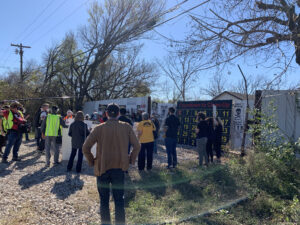 make sure the clean-up itself won’t increase residents’ exposure to hazardous materials like Silica, Formaldehyde, Petroleum By-Products and exotic glues and adhesives used to make shingles that are now crumbling into tons of microscopic particles.
make sure the clean-up itself won’t increase residents’ exposure to hazardous materials like Silica, Formaldehyde, Petroleum By-Products and exotic glues and adhesives used to make shingles that are now crumbling into tons of microscopic particles.
On Monday November 16th, members of Southern Sector Rising, Downwinders at Risk, Southern Dallas Shingle Movers and other protesters gathered at the d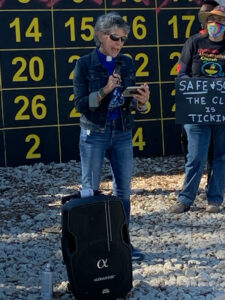 ump’s front gate for an action that hoisted and hooked a huge Clean-Up Countdown Calendar onto the eight-foot-tall metal fence that divides the site from South Central Expressway.
ump’s front gate for an action that hoisted and hooked a huge Clean-Up Countdown Calendar onto the eight-foot-tall metal fence that divides the site from South Central Expressway.
Designed as a giant-size desk calendar, it marked the 30 days of public notice ending on Sunday the 6th. Rev. Frederick Haynes of Friendship-West Baptist Church, Rabbi Nancy Kasten, and the Rev. Amy Moore joined Marsha Jackson and her neighbo rs in speaking about the need to monitor the City and State during this critical phase.
rs in speaking about the need to monitor the City and State during this critical phase.
On the same day, a lengthy expose on Shingle Mountain by Washington Post national climate and environmental reporter Darryl Fears instantly made the dump a national poster child for Environmental Racism.
Two days later, Dallas Mayor Eric Johnson was asked about the Shingle Mountain clean-up by a Channel 8 reporter during his City Hall press conference on rising crime rates in Dallas. His revealing answer beginning with, “It’s really a legal problem,” confirmed the City always had the option of cleaning up the dump, but delayed doing so for over 18 months until it had received money from either the operators or landowners. Admitting that the City could have “solved” this problem early on, Johnson said the City choose not to because that would have made the City’s lawsuit against the landowners “moot.”
Moot is a lawyer’s term that’s defined as “of little or no practical value, meaning, or relevance; purely academic.” Instead of making their lawsuit moot by immediately cleaning up a site causing daily human health damage, Mayor Johnson and the City of Dallas rendered the health of Marsha Jackson and the Choate Street families moot. They made it of little or no practical value in the City’s approach. Of much greater value was the cash received by the landowners. The City sacrificed a street full of its own residents for a lousy $1 million.
In his three-m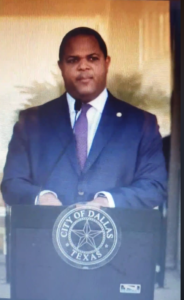 inute response, Johnson never uttered Marsha Jackson’s name, never addressed residents’ health issues, and never expressed regret, second thoughts, or apologies over the year and half the six-story waste pile harmed Choate Street residents. He never admitted the City’s multiple failures in code enforcement, zoning or environmental regulation that paved the way for Shingle Mountain’s creation. He complained how the City was put in a “tough position” – never considering how tough it might be for parents to watch helplessly as their child coughs-up pieces of ground-up shingles. Mayor’s Johnson’s answer was full of legal rationale but completely devoid of humanity or self-awareness. There were no people in it.
inute response, Johnson never uttered Marsha Jackson’s name, never addressed residents’ health issues, and never expressed regret, second thoughts, or apologies over the year and half the six-story waste pile harmed Choate Street residents. He never admitted the City’s multiple failures in code enforcement, zoning or environmental regulation that paved the way for Shingle Mountain’s creation. He complained how the City was put in a “tough position” – never considering how tough it might be for parents to watch helplessly as their child coughs-up pieces of ground-up shingles. Mayor’s Johnson’s answer was full of legal rationale but completely devoid of humanity or self-awareness. There were no people in it.
In short, it was an articulate if soulless synopsis of the City’s position regarding not only Shingle Mountain, but all environmental health problems in Dallas. Because at Dallas City Hall there is no such thing as human-centric environmental problems. What was the City’s first legal response to Shingle Mountain? It wasn’t to cite what an illegal awful abomination it was, but to take it to court over storm water violations. There were no people to worry about. Besides the inability of the City to protect its own residents from illegal hazards is the fact that it continues to treat Choate Street residents as spectators to their own disaster. Marsha Jackson is the Invisible Woman.
In May the Dallas City Council unanimously rejected the pleas of Ms. Jackson and Southern Sector Rising to re-establish the Dallas Environmental Health Commission to give an institutional voice to their concerns within City Hall; to put people back into the mix along with tree planting and water conservation. The Council turned its back on her – again.
That’s why your public comments about maintaining the safety of the pending clean-up are important.
Please show the City of Dallas that you care about Marsha Jackson and the families on Choate Street – even if it doesn’t. Thanks.
CLICK HERE TO SUBMIT YOUR COMMENTS
Robert Wood Johnson Foundation awards grant to Texas A&M and Downwinders at Risk for Joppa Environmental Health Project
Monies will fund unprecedented study of link between health and air pollution in Dallas Freedman’s Town; first effort of its kind in Texas
What’s believed to be the single largest environmental health research investment in a Texas neighborhood was awarded today by the Robert Wood Johnson Foundation to examine the links between human health and air pollution in the Joppa community of Dallas.
 Texas A&M and Downwinders at Risk’s Joppa Environmental Health Project was selected as one of only 16 national proposals funded by the Foundation’s Interdisciplinary Research Leaders grant. Between now and 2022, over $350,000 will be spent by Texas A&M scientists trying to understand the correlation between Particulate Matter air pollution and the health of the Freedman’s Town’s residents.
Texas A&M and Downwinders at Risk’s Joppa Environmental Health Project was selected as one of only 16 national proposals funded by the Foundation’s Interdisciplinary Research Leaders grant. Between now and 2022, over $350,000 will be spent by Texas A&M scientists trying to understand the correlation between Particulate Matter air pollution and the health of the Freedman’s Town’s residents.
Cecilia Wagonner, a member of the Joppa church that hosted a community meeting on air pollution monitoring last December, was enthusiastic about the news. “I want to know the truth and nothing but the truth about air quality in our historic neighborhood. This is definitely good news. Let environmental justice be served.”
Per capita, Joppa is the most polluted neighborhood in Dallas. On one side is the Trinity River. On the other three sides are an asphalt batch plant, Railroad switch yard, large asphalt shingle factory, a concrete batch plant, and Interstate highway. It’s directly downwind from the largest methane air p olluter in Dallas – the City’s McCommas Landfill methane energy recovery unit.
olluter in Dallas – the City’s McCommas Landfill methane energy recovery unit.
Since PM air pollution monitoring began there on August 31st as part of the new SharedAirDFW air monitoring network, Joppa’s PM levels have averaged significantly higher than other sites.
Two Texas A&M scientists based in College Station will lead the new Project. Dr. Natalie Johnson, is an A&M toxicologist specializing in the health effects of Particulate Matter air pollution, and Dr. Ping Ma, is an A&M behavioral and social science researcher who previously worked at Dallas Children’s Hospital specializing in health disparities and social determiners of health. Downwinders will assist with community canvassing and outreach efforts as well as provide technical support through its 11-Joppa based SharedAirDFW network monitors.
They’re now all charged with collecting evidence to discover whether Joppa has higher rates of PM air pollution and health problems than other communities, and understand how differences in daily levels of PM affect residents’ health.
“PM represents a significant ‘unseen’ health risk related to cardiovascular disease, chronic respiratory disease, including lung cancer and asthma, as well as effects on infant development and brain health,” said Johnson. “SharedAirDFW’s real-time pollution monitors will help make this threat ‘seen.”
Ping pointed out the study will be the first academic-community collaboration of its type in Texas. “Our findings will facilitate understanding of the air pollution risks Joppa residents face as well as generate community-based solutions to help create a new culture of environmental health in Joppa.”
Participa nts chosen for the IRL process also become students who receive training in the latest research methods and constant feedback from panels of experienced scientists and experts.
nts chosen for the IRL process also become students who receive training in the latest research methods and constant feedback from panels of experienced scientists and experts.
Grant monies will pay for staff time, graduate assistants, technology, travel, and community outreach over a three-year period.

The IRL grant is the first research project attracted by the SharedAirDFW regional air monitoring network that debuted in September, but Jim Schermbeck, Director of Downwinders, predicted it wouldn’t be the last. “This network makes all kinds of new comparisons and studies possible. In this case, residents and researchers are using it to document Joppa’s air pollution burdens and assist residents in relieving those burdens. That’s a first for Dallas, and Texas.”
From now until the end of the year the Project partners will be assembling their local contacts, refining their timeline and methodology, and getting ready to begin research in early 2021.

/cloudfront-us-east-1.images.arcpublishing.com/dmn/KAAKWCLEMNCRXNYABMHB33CEPA.jpg)
